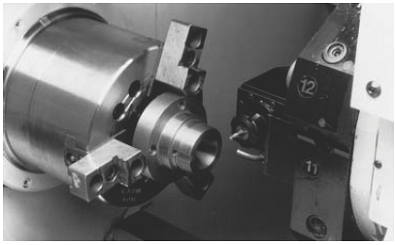Related Resources: Manufacturing
Machining Metal, Applications and Theory
Manufacturing Processes and Design
Machining Metal, Applications and Theory
416 pages
Thomas Childs
University of Leeds, UK
Katsuhiro Maekawa
Ibaraki University, Japan
Toshiyuki Obikawa
Tokyo Institute of Technology, Japan
Yasuo Yamane
Hiroshima University, Japan
This resource requires a Membership (Free)
Open and view: Machining Metal, Applications and Theory
Preface:
Improved manufacturing productivity, over the last 50 years, has occurred in the area of machining through developments in the machining process, in machine tool technology and in manufacturing management. The subject of this book is the machining process itself, but placed in the wider context of manufacturing productivity. It is mainly concerned with how mechanical and materials engineering science can be applied to understand the process better and to support future improvements.
It is intended that this book will be of interest and helpful to all mechanical, manufacturing and materials engineers whose responsibilities include metal machining matters. It is, however, written specifically for masters course students. Masters courses are a major feature of both the American and Japanese University systems, preparing the more able twenty year olds in those countries for the transition from foundation undergraduate courses to useful professional careers. In the UK, masters courses have not in the past been popular, but changes from an elite to a mass higher education system are resulting in an increasingly important role for taught advanced level and continuing professional development courses.
It is supposed that masters course readers will have encountered basic mechanical and materials principles before, but will not have had much experience of their application. A feature of the book is that many of these principles are revised and placed in the machining context, to relate the material to earlier understanding. Appendices are heavily used to meet this objective without interrupting the flow of material too much.
It is a belief of the authors that texts should be informative in practical as well as theoretical detail. We hope that a reader who wants to know how much power will be needed to turn a common engineering alloy, or what cutting speed might be used, or what material properties might be appropriate for carrying out some reader-specific simulation, will have a reasonable chance either of finding the information in these pages or of finding a helpful reference for further searching.

Content:
1 Introduction 1
1.1 Machine tool technology 3
1.2 Manufacturing systems 15
1.3 Materials technology 19
1.4 Economic optimization of machining 24
1.5 A forward look 32
References 34
2 Chip formation fundamentals 35
2.1 Historical introduction 35
2.2 Chip formation mechanics 37
2.3 Thermal modelling 57
2.4 Friction, lubrication and wear 65
2.5 Summary 79
References 80
3 Work and tool materials 81
3.1 Work material characteristics in machining 82
3.2 Tool materials 97
References 117
4 Tool damage 118
4.1 Tool damage and its classification 118
4.2 Tool life 130
4.3 Summary 134
References 135
5 Experimental methods 136
5.1 Microscopic examination methods 136
5.2 Forces in machining 139
5.3 Temperatures in machining 147
5.4 Acoustic emission 155
References 157
6 Advances in mechanics 159
6.1 Introduction 159
6.2 Slip-line field modelling 159
6.3 Introducing variable flow stress behaviour 168
6.4 Non-orthogonal (three-dimensional) machining 177
References 197
7 Finite element methods 199
7.1 Finite element background 199
7.2 Historical developments 204
7.3 The Iterative Convergence Method (ICM) 212
7.4 Material flow stress modelling for finite element analyses 220
References 224
8 Applications of finite element analysis 226
8.1 Simulation of BUE formation 226
8.2 Simulation of unsteady chip formation 234
8.3 Machinability analysis of free cutting steels 240
8.4 Cutting edge design 251
8.5 Summary 262
References 262
9 Process selection, improvement and control 265
9.1 Introduction 265
9.2 Process models 267
9.3 Optimization of machining conditions and expert system applications 283
9.4 Monitoring and improvement of cutting states 305
9.5 Model-based systems for simulation and control of machining
processes 317
References 324
Appendices
1 Metals’ plasticity, and its finite element formulation 328
A1.1 Yielding and flow under triaxial stresses: initial concepts 329
A1.2 The special case of perfectly plastic material in plane strain 332
A1.3 Yielding and flow in a triaxial stress state: advanced analysis 340
A1.4 Constitutive equations for numerical modelling 343
A1.5 Finite element formulations 348
References 350
2 Conduction and convection of heat in solids 351
A2.1 The differential equation for heat flow in a solid 351
A2.2 Selected problems, with no convection 353
A2.3 Selected problems, with convection 355
A2.4 Numerical (finite element) methods 357
References 362
3 Contact mechanics and friction 363
A3.1 Introduction 363
A3.2 The normal contact of a single asperity on an elastic foundation 365
A3.3 The normal contact of arrays of asperities on an elastic foundation 368
A3.4 Asperities with traction, on an elastic foundation 369
A3.5 Bulk yielding 371
A3.6 Friction coefficients greater than unity 373
References 374
4 Work material: typical mechanical and thermal behaviours 375
A4.1 Work material: room temperature, low strain rate, strain hardening
behaviours 375
A4.2 Work material: thermal properties 376
A4.3 Work material: strain hardening behaviours at high strain rates and
temperatures 379
References 381
5 Approximate tool yield and fracture analysis 383
A5.1 Tool yielding 383
A5.2 Tool fracture 385
References 386
6 Tool material properties 387
A6.1 High speed steels 387
A6.2 Cemented carbides and cermets 388
A6.3 Ceramics and superhard materials 393
References 395
7 Fuzzy logic 396
A7.1 Fuzzy sets 396
A7.2 Fuzzy operations 398
References 400
Index 401
Related:
- Machine Shop and Manufacturing Definitions
- Electrical Discharge Machining ( EDM ) Design Consideration Process Capabilities
- Swiss Screw Machine & Manufacturing Review
- Multi-Axis CNC Machining Crankshaft
- Why DFM/DFA is Business Critical
- Design for Manufacturability and Concurrent Engineering
- Design for Manufacturability and Assembly DFM DFMA
- Overview Design for Manufacturability
- Milling Machines and Process Review